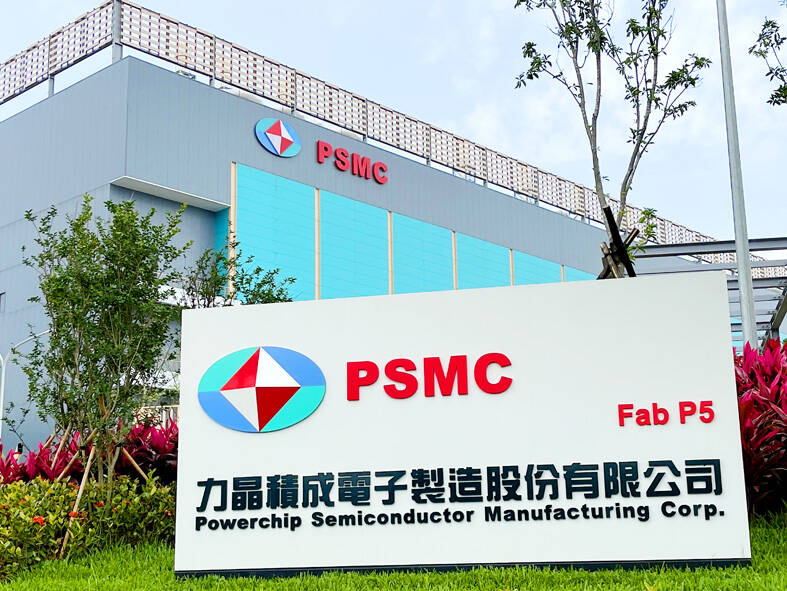Powerchip Semiconductor Manufacturing Co (力積電) yesterday said that net losses ballooned to NT$1.96 billion (US$60.1 million) in the second quarter, as heavy manufacturing costs from a new fab outweighed the improvement in customer demand and factory utilization.
That compared with losses of NT$439 million in the first quarter. The company posted a net profit of NT$617 million a year earlier.
Gross margin plummeted to 5.3 percent last quarter, from 15.4 percent in the previous quarter and 16.8 percent in the same period last year. It was the weakest since the fourth quarter of last year.

Photo: Grace Hung, Taipei Times
The chipmaker blamed heavy depreciation and higher manufacturing costs from its new 12-inch fab in Miaoli County’s Tongluo Science Park (銅鑼科學園區) behind the decline in gross margin.
“The Tongluo fab, or P5, started its pilot run in the second quarter, which was the main reason why we saw a 10 percentage point drop in gross margin last quarter,” company spokesman Eric Tang (譚仲民) told a virtual investors’ conference.
“The P5 fab has not reached economies of scale, given its smaller installed capacity,” Tang said. “It will take time to offset that adverse impact beyond the second half of this year.”
Powerchip plans to ramp up the fab’s production to reach its initial capacity of 8,500 12-inch wafers a month by the end of this year at the earliest, Tang said.
However, that would still be less than halfway to the break-even point of 20,000 wafers, he said.
With the P5 fab joining operations, the chipmaker expects depreciation costs this year to swell to about NT$9.5 billion or NT$10 billion, from NT$6 billion a year during normal times, Powerchip chief financial officer Jerry Shao (邵章榮) told investors.
The chipmaker cut its capital spending for this year to US$944 million from an earlier estimate of US$1.04 billion.
“The company’s third-quarter revenue would grow slightly compared with the second quarter,” Tang said, as Powerchip expects a mild recovery in chip demand for smartphones, notebook computers, vehicles and networking devices.
In the second quarter, revenue rose 2.7 percent to NT$10.82 billion, the chipmaker said.
Factory utilization should further pick up to about 90 percent for memorychip production lines and more than 80 percent for power management chips, driver ICs and CMOS image sensors, Tang said.
Utilization of less advanced 8-inch fabs would stand at about 70 percent this quarter, he said.
Average selling prices are stabilizing and should recover this quarter, he added.
The company is also exploring new business opportunities with chip designers to supply power management chips used in artificial intelligence devices, Tang said.
The new chips would be made at the P5 fab and start generating revenue next year, he said.
Additionally, Powerchip is to supply driver ICs and CMOS image sensors for the world’s major chip designers and some Chinese chip companies, which are seeking manufacturing capacity outside of China amid escalating geopolitical tensions, Tang said.

Shiina Ito has had fewer Chinese customers at her Tokyo jewelry shop since Beijing issued a travel warning in the wake of a diplomatic spat, but she said she was not concerned. A souring of Tokyo-Beijing relations this month, following remarks by Japanese Prime Minister Sanae Takaichi about Taiwan, has fueled concerns about the impact on the ritzy boutiques, noodle joints and hotels where holidaymakers spend their cash. However, businesses in Tokyo largely shrugged off any anxiety. “Since there are fewer Chinese customers, it’s become a bit easier for Japanese shoppers to visit, so our sales haven’t really dropped,” Ito

The number of Taiwanese working in the US rose to a record high of 137,000 last year, driven largely by Taiwan Semiconductor Manufacturing Co’s (TSMC, 台積電) rapid overseas expansion, according to government data released yesterday. A total of 666,000 Taiwanese nationals were employed abroad last year, an increase of 45,000 from 2023 and the highest level since the COVID-19 pandemic, data from the Directorate-General of Budget, Accounting and Statistics (DGBAS) showed. Overseas employment had steadily increased between 2009 and 2019, peaking at 739,000, before plunging to 319,000 in 2021 amid US-China trade tensions, global supply chain shifts, reshoring by Taiwanese companies and

Taiwan Semiconductor Manufacturing Co (TSMC, 台積電) received about NT$147 billion (US$4.71 billion) in subsidies from the US, Japanese, German and Chinese governments over the past two years for its global expansion. Financial data compiled by the world’s largest contract chipmaker showed the company secured NT$4.77 billion in subsidies from the governments in the third quarter, bringing the total for the first three quarters of the year to about NT$71.9 billion. Along with the NT$75.16 billion in financial aid TSMC received last year, the chipmaker obtained NT$147 billion in subsidies in almost two years, the data showed. The subsidies received by its subsidiaries —

Taiwan Semiconductor Manufacturing Co (TSMC) Chairman C.C. Wei (魏哲家) and the company’s former chairman, Mark Liu (劉德音), both received the Robert N. Noyce Award -- the semiconductor industry’s highest honor -- in San Jose, California, on Thursday (local time). Speaking at the award event, Liu, who retired last year, expressed gratitude to his wife, his dissertation advisor at the University of California, Berkeley, his supervisors at AT&T Bell Laboratories -- where he worked on optical fiber communication systems before joining TSMC, TSMC partners, and industry colleagues. Liu said that working alongside TSMC